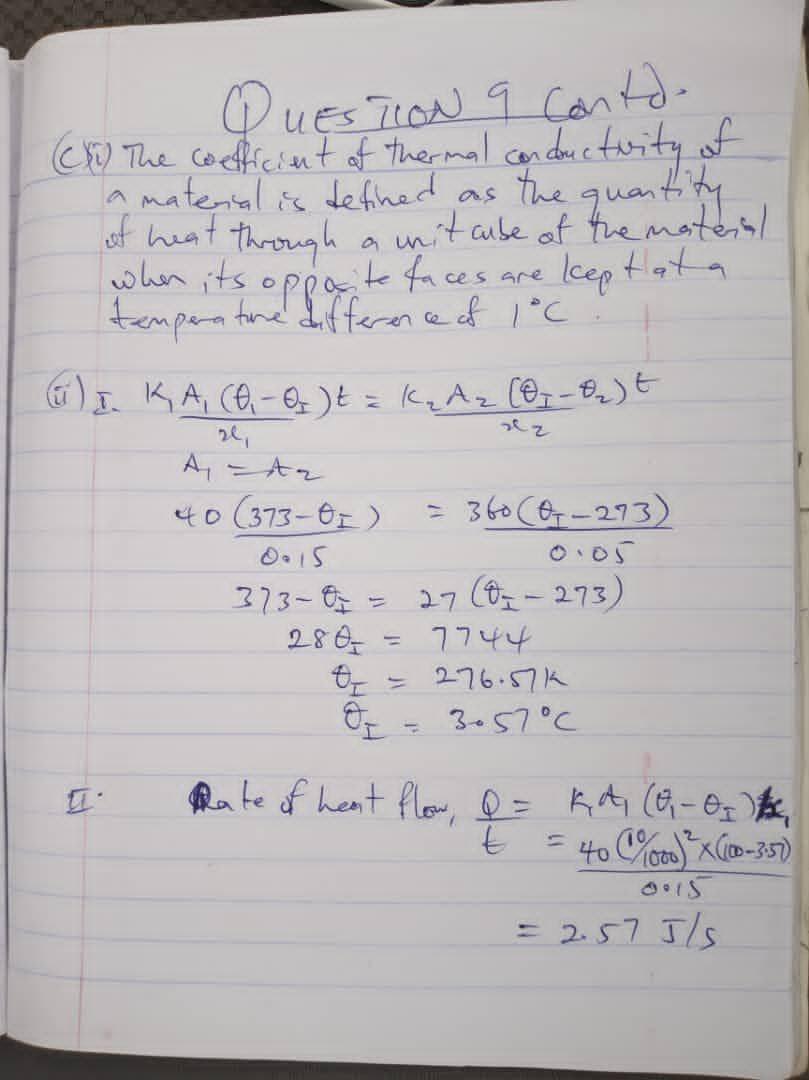WWW.SOLUTIONFANS.COM - MASTER OF ALL EXAM RUNS
Physics-Obj:
1AAABACCDDB
11ACCDCBCBAC
21CCCBBDDBBB
31ACBBCCCAAD
41BBADCCBAAC
(1)
Workdone = 1/2Fe
= 1/2 × 4.0 × 1/100
= 2/100 = 0.02J
===================================
(2a)
(i)Navigation satellites e.g global position system – GPS
(ii) Communication satellites eg ANIK
(2b)
V = 2πR/T
For every second,
Speed, V = 2πR
V = 2 × 22/7 × 6300
V = 39,600km/s
===================================
(3)
V=u cosθ -gt
V=40*cos30-10*1
V=34.64-10
V=24.64m/s
(4a)
A safely separates the incoming AC voltage from the secondary side which is adjusted to control the output voltage of the rectifier
(4b)
B smothers the pulsating output voltage
===================================
(5a)
Wave particles duality is the concept in quantum mechanics that every particles or quantum entitle may be described as either a particle or wave.
(5b)
λ=h/MV
4.2*10^-¹¹=h/1.6*10^-²³
h=4.2*10^-¹¹ * 1.6*10^-²³
h=6.72*10^-³⁴
===================================
(6)
(i)reflection
(ii)refraction
(iii)diffraction
(7a)
Fiber optics work on the principle of total internal reflection.
(7bi)
Core: This is the light transmission area of the fiber, either glass or plastic.
(7bii)
cladding is made of a material with a slightly lower index of refraction than the core
(8ai)
Hooke’s law states that the extension e produced by an elastic material is directly proportional to the applied force provided the elastic unit is not exceeded.
(8aii)
(i) Given extension, e = I2 – I1 = 0.75 – 0.20 = 0.55m
Force applied, Fe = (1.95 – 0.30) × 10
= 1.65 × 10 = 16.5N
Force constant , K = F/R = 16.5/0.55 = 30N/m
(ii) Using F = K (I1 – Io)
m1g = K ( I1 – Io)
= 0.30 × 10 = 30(0.20 – Io)
= 0.10 = 0.20 – Io
Io = 0.20 – 0.10
Io = 0.10m
Length of spring when it was unloaded = 0.10m
(8bi)
Diffusion is the net movement of particles from a region of higher concentration to a region of lower concentration.
(8bii)
(i) Temperature
(ii) Size of particles
(8biii)
Rate of diffusion is inversely proportional to the square root of density under given conditions of temperature and pressure. ie R ∝ 1/√d
(8c)
T = circumference of the orbit/orbit velocity
T = 2πR/v
But V = √GM/R
T = 2π√R³/GM
(9ai)
The dew point is the temperature to which air must be cooled to become saturated with water vapor.
(9aii)
Dew is a condensation phenomenon. The water vapour when cooled below its dew point and now comes in contact with a colder surface forms a dew. The metal part of the bicycle tends to be colder than rubber part of the bicycle because the metal surface get cold easily.
(9bi)
The specific heat capacity of copper is 400 JKg−¹K−¹ means that 400 J of heat energy is required to raise or lower the temperature of 1kg of a piece of copper by 1 kelvin.
(9bii)
Qp = Qq
Cp/Cq =3
Mp/Mq=¹/²
MpCpΔQp =MqCqΔQq
Δθp/Δθp=Mq/Mp Cq/Cq
=2*¹/³
Δθp ; Δθq =2:3
(9ci)
The coefficient of thermal conductivity of material is depending on temperature, physical properties of the material, water content, and the pressure on the material. In other words is the quantity of heat through a unit cube of material when it opposite faces are kept. The coefficient k is measured in watts per meter Kelvin (or degree) (W/mK).
(9cii)
(11ai)
Root measurement value of an alternating current is the value of A.C current that has the same heating affect as a D.C current
(11aii)
Impedance is the affective resistance of an electric circuit arising from the combined affects of ohmic resistance and reactance .( ie resistors, indicators and capacitors)
(11b)
Current in circuit , I = 60/120 = 0.5A
Voltage across device , Vr = 120V
Voltage across capacitor , Vc = √V² – Vr
Vc = √240² – 120²
Vc = 207.846V
Ic = I = 0.5
Xc = Vc/Ic = 207.846/0.5 = 415.7Ω
Capacitance, C = Xc/2πf = 415.7/2*3.142*50 = 1.323F
(11ci)
The capacitance of a capacitor is the ratio of the amount of charge on its plates to the potential difference between them. ie C = ∑/V
(11cii)
(i) Charge in both capacitors are the same
∑1 = Q2
ie C1V1 = C2V2 ………(1)
Total capacitance ,C = C1C2/C1+C2
C = C2/1+C2/C1 = C2/1+V/V2
C = C2V2/V1+V2 = C2V2/2
C= 1/2C2V2
(ii)Voltage across, V1 = (C2/C1+C2) × V
V1 = (C1/C1+C2) × V
But C1/C2 = d2/d1 = 5/2
V1 = (1/(5/2+1)) × 2 = 2/7 ×2 = 4/7Volts
Voltage across, C2 : V2 = 2-4/7 = 10/7volts
(12ai)
A radioactive nucleus is said to be relatively stable if it does not further disintegrate or form any other atomic nucleus
(12aii)
Reason; The more the atomic mass of a nucleus, the more it’s radioactive tendency an the lesser it’s stability
(12bi)
Ionization potential is the amount of energy eV, which helps to remove an electron completely from an atom. It is represented with V.
(12bii)
E = eV
IeV = 1.6×10-¹⁹
V = hv/λ where h is the planks constant
h = 6.626 ×10-³⁴ , c = 3×10⁸m , λ = 1.02 × 10-⁷m
E = (1.6×10-¹⁹) × (6.626 ×10-³⁴) × (3×10⁸)/1.02 × 10-⁷
E = 31.805 × 10-⁴⁵/1.02 × 10-⁷
E = 31.2 × 10-³⁸ volts
(12c)
(i)
This means that the amount of energy needed by sodium for an electron to be knocked out by electromagnetic radiation is 2.0V.
(ii) λ = 160nm , Wo = 2.0V
Wo = 2.0 × 1.6 × 10-¹⁹
Wo = 3.2 × 10-¹⁹J
Energy of radiation E = hc/λ
(12cii)
λ = 160×10-⁹m
= 1.60×10-⁹m
E = hc/λ
= 6.6×10-⁹×3×10⁸/1.6×10-⁷
= 6.6×3×10-³⁴+⁸+¹⁹/1.6
= 12.37×10-¹⁹
E = 1.239×10-¹⁸J
Photoelectron will be emitted because the energy of the photon us greater than work function of the metal
also don't forget to leave a Reply, we would very MUCH appreciate Your Comments On This Post Below. Thanks!

